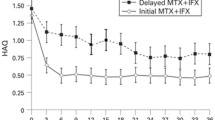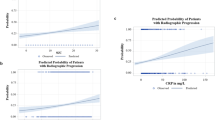Abstract
Tumour necrosis factor (TNF) antagonists or blocking agents represent a major advance in the treatment of rheumatoid arthritis (RA), but their use raises economic concerns because of the high drug cost. Population-based patient registers with clinical data allow the estimation of the proportion of patients with RA who are eligible for TNF antagonist therapy according to recent consensus statements on TNF-targeted therapy.
Data were derived from a representative county-based (500 000 population) register of patients with RA. Of 894 patients aged between 18 and 70 years, 636 (71%) [females 80%, mean (SD) age 53.6 (12.2) years and mean (SD) disease duration 12.2 (9.3) years] had a clinical and radiographic examination. The eligibility for TNF-targeted therapy was estimated from the following criteria: (i) previous or current therapy with at least one disease-modifying antirheumatic agent (DMARD); and (ii) active disease. Disease activity criteria were set to 28-swollen joint count (28-SJC) ≥6, 28-tender joint count ≥6, and erythrocyte sedimentation rate (ESR) ≥28 mm/hour or C-reactive protein (CRP) ≥20 mg/L. Sensitivity analyses were performed varying some of these disease activity parameters.
Of the 636 patients, as many as 526 (83%) had previously or were currently using DMARDs and 98 (15%) fulfilled both the DMARD and activity criteria, thus being the maximum number of patients considered for TNF-targeted therapy. If the most stringent criteria were used (ever DMARD, 28-SJC ≥12 and ESR ≥50 mm/hour or CRP ≥40 mg/L) only 15 of the 626 (2%) would be candidates for TNF-targeted therapy. In a population of 1 million, assuming a prevalence of 2000 patients with RA under the age of 70 years, the number of candidates for TNF-targeted therapy would be 40 to 300, depending on the disease activity criteria. Stringent ESR and CRP criteria would lead to a major reduction in the number of eligible patients. These utilisation data imply annual drug costs in the range of $US480 000 to $US3 600 000 for TNF antagonists for RA per 1 million population. Further economic evaluations are needed to determine for which groups such treatment is warranted from a health economics perspective.






Similar content being viewed by others
References
Pincus T, Callahan LF. What is the natural history of rheumatoid arthritis [review]? Rheum Dis Clin North Am 1993; 19: 123–51
Uhlig T, Smedstad LM, Vaglum P, et al. The course of rheumatoid arthritis and predictors of psychological, physical and radiographic outcome after 5 years of follow-up. Rheumatology (Oxford) 2000; 39(7): 732–41
Eberhardt KB, Fex E. Functional impairment and disability in early rheumatoid arthritis — development over 5 years. J Rheumatol 1995; 22: 1037–42
Hakala M, Nieminen P, Koivisto O. More evidence from a community based series of better outcome in rheumatoid arthritis. Data on the effect of multidisciplinary care on the retention of functional ability. J Rheumatol 1994; 21: 1432–7
Weinblatt ME, Kremer JM, Bankhurst AD, et al. A trial of etanercept, a recombinant tumor necrosis factor receptor: Fc fusion protein, in patients with rheumatoid arthritis receiving methotrexate [see comments]. N Engl J Med 1999; 340(4): 253–9
Maini R, St Clair EW, Breedveld F, et al. Infliximab (chimeric anti-tumour necrosis factor alpha monoclonal antibody) versus placebo in rheumatoid arthritis patients receiving concomitant methotrexate: a randomised phase III trial. ATTRACT Study Group. Lancet 1999; 354(9194): 1932–9
Lipsky PE, van der Heijde DM, St Clair EW, et al. Infliximab and Methotrexate in the Treatment of Rheumatoid Arthritis. N Engl J Med 2000; 343(22): 1594–602.
Bathon JM, Martin RW, Fleischmann RM, et al. A Comparison of Etanercept and Methotrexate in Patients with Early Rheumatoid Arthritis. N Engl J Med 2000; 343(22): 1586–93
Choi HK, Seeger JD, Kuntz KM. A cost-effectiveness analysis of treatment options for patients with methotrexate-resistant rheumatoid arthritis. Arthritis Rheum 2000; 43(10): 2316–7
Kvien TK, Glennås A, Knudsrød OG, et al. The prevalence and severity of rheumatoid arthritis in Oslo. Results from a county register and a population survey. Scand J Rheumatol 1997; 26(6): 412–8
Scott DL, Adebajo AO, el Badaway S, et al. DC-ART: preventing or significantly decreasing the rate of progression of structural joint damage [review]. J Rheumatol Suppl 1994; 41: 36–40
Egsmose C, Lund B, Borg G, et al. Patients with rheumatoid arthritis benefit from early 2nd line therapy: 5 year followup of a prospective double blind placebo controlled study. J Rheumatol 1995; 22(12): 2208–13
Paulus HE, Bulpitt KJ. DC-ART classification: review of relevant clinical studies. [Review]. J Rheumatol Suppl 1994; 41: 8–20
Borg G, Allander E, Lund B, et al. Auranofin improves outcome in early rheumatoid arthritis. Results from a 2-year, double blind, placebo controlled study. J Rheumatol 1988; 15: 1747–54
Kirwan JR. The effect of glucocorticoids on joint destruction in rheumatoid arthritis. The Arthritis and Rheumatism Council Low-Dose Glucocorticoid Study Group [see comments]. N Engl J Med 1995; 333: 142–6
Rau R, Herborn G, Menninger H, et al. Progression in early erosive rheumatoid arthritis: 12 month results from a randomized controlled trial comparing methotrexate and gold sodium thiomalate. Br J Rheumatol 1998; 37(11): 1220–6
Førre Ø, Norwegian Arthritis Study Group. Radiographic evidence of disease modification in rheumatoid arthritis patients treated with cyclosporine. Results of a 48-week multicenter study comparing low-dose cyclosporine with placebo. Arthritis Rheum 1994; 37: 1506–2
Glennås A, Kvien TK, Andrup O, et al. Auranofin is safe and superior to placebo in elderly-onset rheumatoid arthritis. Br J Rheumatol 1997; 36(8): 870–7
Smolen JS, Kalden JR, Scott DL, et al. Efficacy and safety of leflunomide compared with placebo and sulphasalazine in active rheumatoid arthritis: a double-blind, randomised, multicentre trial. European Leflunomide Study Group. Lancet 1999; 353(9149): 259–66
Felson DT, Anderson JJ, Meenan RF. The efficacy and toxicity of combination therapy in rheumatoid arthritis. A meta-analysis. Arthritis Rheum 1994; 37: 1487–91
Tugwell P, Pincus T, Yocum D, et al. Combination therapy with cyclosporine and methotrexate in severe rheumatoid arthritis. The Methotrexate-Cyclosporine Combination Study Group [see comments]. N Engl J Med 1995; 333: 137–41
O’Dell JR, Haire CE, Erikson N, et al. Treatment of rheumatoid arthritis with methotrexate alone, sulfasalazine and hydroxychloroquine, or a combination of all three medications. N Engl J Med 1996; 334(20): 1287–91
Suarez-Almazor ME, Soskolne CL, Saunders LD, et al. Outcome in rheumatoid arthritis. A 1985 inception cohort study. J Rheumatol 1994; 21: 1438–46
Wolfe F, Hawley DJ, Cathey MA. Termination of slow acting antirheumatic therapy in rheumatoid arthritis: a 14-year prospective evaluation of 1017 consecutive starts. J Rheumatol 1990; 17: 994–1002
Emery P. Rheumatoid arthritis: not yet curable with early intensive therapy. Lancet 1997; 350(9074): 304–5
Moreland LW, Schiff MH, Baumgartner SW, et al. Etanercept therapy in rheumatoid arthritis. A randomized, controlled trial. Ann Intern Med 1999; 130(6): 478–86
Lovell DJ, Giannini EH, Reiff A, et al. Etanercept in children with polyarticular juvenile rheumatoid arthritis. Pediatric Rheumatology Collaborative Study Group [see comments]. N Engl J Med 2000; 342(11): 763–9
Mease PJ, Goffe BS, Metz J, et al. Etanercept in the treatment of psoriatic arthritis and psoriasis: a randomised trial. Lancet 2000; 356(9227): 385–90
Elliott MJ, Maini RN, Feldmann M, et al. Treatment of rheumatoid arthritis with chimeric monoclonal antibodies to tumor necrosis factor alpha. Arthritis Rheum 1993; 36(12): 1681–90
Elliott MJ, Maini RN, Feldmann M, et al. Repeated therapy with monoclonal antibody to tumour necrosis factor alpha (cA2) in patients with rheumatoid arthritis. Lancet 1994; 344(8930): 1125–7
Elliott MJ, Maini RN, Feldmann M, et al. Randomised double-blind comparison of chimeric monoclonal antibody to tumour necrosis factor alpha (cA2) versus placebo in rheumatoid arthritis. Lancet 1994; 344(8930): 1105–0
Maini RN, Breedveld FC, Kalden JR, et al. Therapeutic efficacy of multiple intravenous infusions of anti-tumor necrosis factor alpha monoclonal antibody combined with low-dose weekly methotrexate in rheumatoid arthritis [see comments]. Arthritis Rheum 1998; 41(9): 1552–63
van der Heijde DMFM, Emery P, et al. Consistent improvement in radiographic joint damage in patients with active rheumatoid arthritis treated with infliximab along with methotrexate [abstract]. Scand J Rheumatol 2000; 45 Suppl. 112: 64
Furst DE, Breedveld FC, Burmester GR, et al. Access to disease modifying treatments for rheumatoid arthritis patients. Ann Rheum Dis 1999; 58 Suppl. 1:1129–30
Furst DE, Breedveld FC, Burmester GR, et al. Updated consensus statement on tumour necrosis factor blocking agents for the treatment of rheumatoid arthritis (May 2000). Ann Rheum Dis 2000; 59 Suppl. 1:11–2
Smolen JS, Breedveld FC, Burmester GR, et al. Consensus statement on the initiation and continuation of tumour necrosis factor blocking therapies in rheumatoid arthritis. Ann Rheum Dis 2000; 59(7): 504–5
Uhlig T, Kvien TK, Glennas A, et al. The incidence and severity of rheumatoid arthritis, results from a county register in Oslo, Norway. J Rheumatol 1998; 25(6): 1078–84
Arnett FC, Edworthy SM, Bloch DA, et al. The American Rheumatism Association 1987 revised criteria for the classification of rheumatoid arthritis. Arthritis Rheum 1988; 31: 315–24
Kvien TK, Glennas A, Knudsrod OG, et al. The validity of self-reported diagnosis of rheumatoid arthritis: results from a population survey followed by clinical examinations. J Rheumatol 1996; 23(11): 1866–71
Van Riel PL. Provisional guidelines for measuring disease activity in clinical trials on rheumatoid arthritis [editorial]. Br J Rheumatol 1992; 31: 793–4
Prevoo ML, van’t Hof MA, Kuper HH, et al Modified disease activity scores that include twenty-eight-joint counts. Development and validation in a prospective longitudinal study of patients with rheumatoid arthritis. Arthritis Rheum 1995; 38: 44–8
Moreland LW, Cohen SB, Baumgartner SW, et al. Long-term safety and efficacy of etanercept in patients with rheumatoid arthritis. J Rheumatol 2001; 28(6): 1238–44
Pincus T, Stein CM. What is the best source of useful data on the treatment of rheumatoid arthritis: clinical trials, clinical observations, or clinical protocols? J Rheumatol 1995; 22(9): 1611–7
Brandt J, Haibel H, Comely D, et al. Successful treatment of active ankylosing spondylitis with the anti-tumor necrosis factor alpha monoclonal antibody infliximab. Arthritis Rheum 2000; 43(6): 1346–52
Acknowledgements
We thank the research nurses Ingerid Müller and Catherine Planke for assistance with the data collection, research secretary Kirsten Mossin for keeping the Oslo RA register updated and medical student Espen Haavardsholm for data entry. Till Uhlig, MD was at the time of the study financially supported by the Research Council of Norway.
Author information
Authors and Affiliations
Corresponding author
Rights and permissions
About this article
Cite this article
Kvien, T.K., Uhlig, T. & Kristiansen, I.S. Criteria for TNF-Targeted Therapy in Rheumatoid Arthritis. Drugs 61, 1711–1720 (2001). https://doi.org/10.2165/00003495-200161120-00003
Published:
Issue Date:
DOI: https://doi.org/10.2165/00003495-200161120-00003




